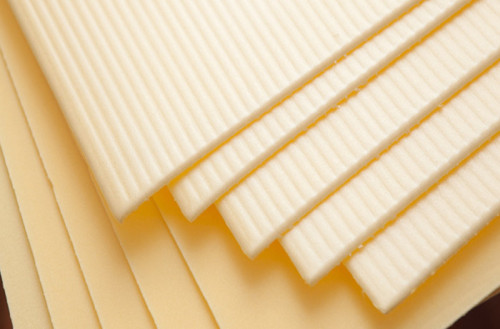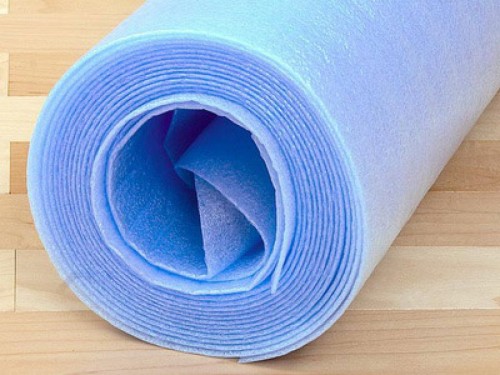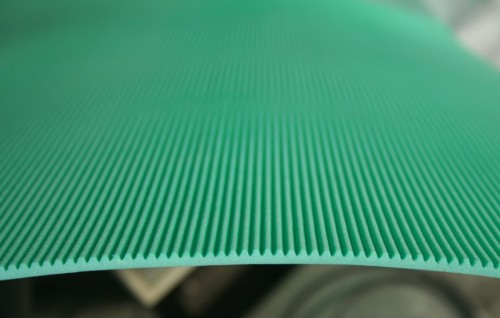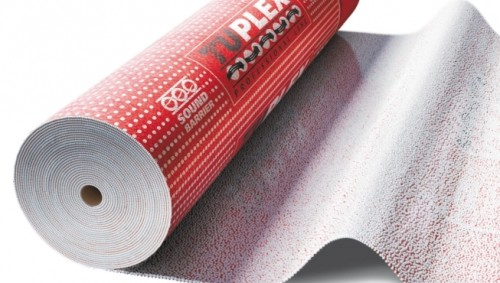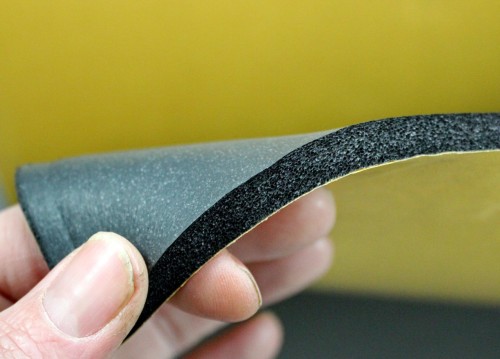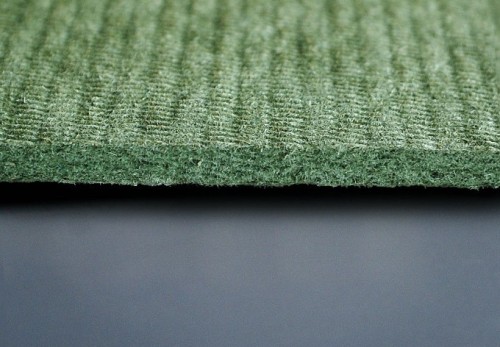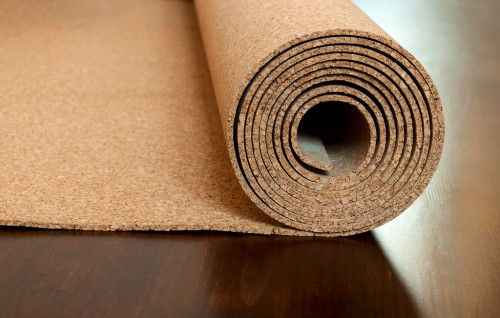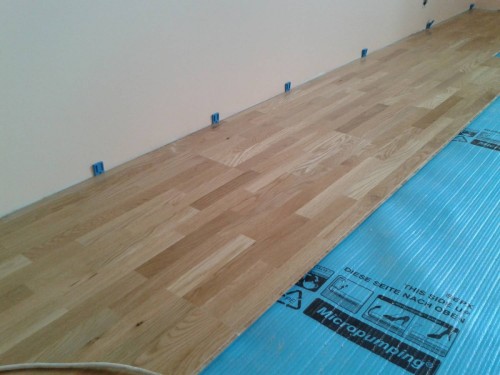Laminate is a beautiful, reliable and warm floor covering, which can decorate almost any interior. But the choice of high-quality laminate is only half of the case. So that the floor in the room served for many years, and its facing retained the attractiveness and good performance characteristics, it is also important to choose the properly to pick up the substrate. To find out what kind of laminate substrate is better, it is necessary to deal with its species and properties that we will try to do in this article.
Content
The main functions of the substrate
Laying the laminate on the floor can not do without a substrate. When determined with what kind of substrate to choose under the laminate, you should pay attention to those functions that this material performs:
- One of the main purpose of the substrate is noise insulation. While walking along laminated coating, the sounds of steps are distributed quite loudly, and not only households are heard, but also neighbors. The thickness of the laminate is small, and during the laying of the coating, a floating method is used. As a result, the material acts as a peculiar membrane, perfectly transmitting sounds. The substrate in this case helps to repay the noise and make a stay in the room more comfortable. Some laminate manufacturers make goods with a ready-made soundproofing layer, as a rule, the laminate of 33 and 32 classes appears in such material. It should be noted that the laminate with the finished substrate is noticeably more expensive than its analogues, so those who want to save, it will be cheaper to buy a substrate separately.
- The second function for which the substrate is intended is the leveling of the surface. It is impossible to deny that sometimes the band screed is performed not too high quality and has some irregularities. Too significant flaws and height differences can be an obstacle to laying the laminate, since individual coating fragments will not be able to docile smoothly. Some time, after repair, the plates of laminate can also seek or form gaps and gaps. This is fraught with discomfort while walking, since the floor will vibrate and fuse, as well as the spoofing of the finest coverage. The substrate is designed to get rid of such problems, it levels the heights of the concrete surface and will allow the coating to lie smoothly.
- Moisture insulation is another of the purpose of the substrate under the laminate. It is known that the floor covering of this type is made of wood - material well absorbing moisture and capable of deforming under its impact. The substrate helps maintain a favorable microclimate between the draft floor and the coating of laminate, preventing moisture in the wood. By the way, the laminate on the concrete floor can only be laid in the event that the screed is good. As a rule, this process takes at least 1 month. Check the level of the humidity of the concrete is very easy: to put a polyethylene film or a package to the floor. If you find the droplets of moisture on the oil in the morning - the floor is not ready for lining with laminated coating.
- Thermal insulation of the floor covering also relates to the useful functions of the substrate. Laminate, which is manufactured from wood, is considered to be "warm" material, that is, such that is capable of holding the high temperature indoors. The substrate only enhances such qualities of laminate and makes stay in the room even more comfortable.
So, we found out that the substrate for laminate has a number of useful qualities and is a mandatory material when laying outdoor coverage. Of course, the substrate is not very cheap, but the experience of many people shows that it is not worth saving on it, because subsequently such savings can turn into deposits. To find the optimal substrate option, you should pay attention not only at its price, but also on other characteristics. We will understand what features a high-quality substrate for laminate is distinguished:
- it should be moisture resistant and waterproof;
- it is desirable that the substrate has a good heat;
- the substrate should also be environmentally friendly;
- the material should not create favorable conditions for the reproduction of microorganisms;
- the substrate should not enter into chemical reactions with alkaline compositions;
- it is desirable to choose the material that will provide the possibility of gender micovetyering;
- the substrate must also be moderately soft, which will help reduce load on the locking of the laminate fragments.
Types of substrates under laminate
To decide which substrate for laminate is better, it should be understood in the existing types of material. We'll figure it out in more detail in this matter.
Polypropylene foamed substrate
The advantages of the substrate from the foamed polypropylene can be considered such characteristics:
- The material has good heat insulating properties, as well as good vibrations, arising in the process of covering coating.
- Such a substrate is resistant to the action of fungi, is not subject to attacks of rodents, does not contribute to the reproduction of microorganisms in its thicker.
- Polypropylene is not subject to alkaline reaction in the process of interaction with concrete and primer, and also does not respond to other chemicals and solvents.
- Such material does not miss moisture.
- It is environmentally friendly and safe for health, since it is made from non-toxic components.
Among the minuses can be selected as follows:
- After 7-10 years, the substrate from the foamed polypropylene may crumble into parts, so that it will have to be completely changed.
- The material is not suitable for large static loads. Being under the press, the substrate loses shape, air bubbles inside the material are bursting, and polypropylene is thinned.
- Foamed polypropylene does not have good soundproof properties.
The substrate of this species should be laid on the floor only in 1 layer. A larger number of layers will lead to a strong drawdown of laminate, as a result of which the latter can deform. Separate substrate fragments are bonded with a glue or tape.
Extruded polystyrene substrate
Foamed polystyrene used as a substrate for laminate, well withstands strong static loads. The pluses of the material also include its waterproof and not bad thermal insulation characteristics. Such a substrate is not damaged by insects and rodents, it does not multiply bacteria and mushrooms. In addition, laying material on the floor is performed quickly and easily.
The disadvantages of the substrate of this type include its flammability, as well as the ability to allocate poisonous substances in the process of combustion. In addition, polystyrene is relatively short-lived and after 6-7 years of operation loses its useful properties. To put such a material should be only on a very even basis, since the leveling ability in such a substrate is not very good.
Substrate from Tuprel
Tomplex is a composite material consisting of 2 layers of polyvinyl chloride film and a layer of granulated polystyrene. The thickness of such a substrate exceeds 3 mm, on both sides, the material is additionally covered with high-strength polyethylene, which improves the performance of the inkrels. Such a substrate has a number of advantages:
- It is moisture resistant, but vapor permeable. Micro-rosencies that are on the inside of the inner side of the inner side, let moisture particles through the material layer.
- Tomples has good soundproofing qualities.
- It is easily and quickly laid on the base, such material is often used when creating a warm floor.
- The material transfers static loads, almost not deformed and serves for many years.
Rubber substrates for laminate
Rubber substrates relate to integrated materials, that is, they are immediately glued to the laminate at the stage of its production. From above rubber is protected by a thin layer of a non-wedroom material, which allows you to extend the life of the substrate. Rubber has good strength, it is not deformed by loads, no moisture is afraid, and also absorbs vibrations and noise arising in the process of walking on the coating. The disadvantage of flooring equipped with a rubber substrate is its high price.
Coniferous substrate for laminate
A coniferous substrate for laminate is very actively advertised on the Russian market. It is somewhat higher than on other analogs, but such a substrate is positioned as high quality and durable material. It should be noted that the thickness of the coniferous substrate is from 4 to 7 mm, and many laminate manufacturers recommend laying the floor covering on a substrate not exceeding 3 mm in thickness, otherwise the laminate can already be replaced by warranty. Among other things, some manufacturers of a coniferous substrate claim that their products can simultaneously perform 2 functions: be a bedding under laminate, as well as play the role of the main flooring. Such statements should be expected wary, because in the first case the material should have sufficient softness, and in the second - to be tough and solid.
Meanwhile, it is impossible to not pay attention to the positive properties of the coniferous substrate, to which the following characteristics can be attributed:
- Such material has excellent noise absorbing properties. In the room where the floor is covered with a coniferous substrate, it will be quiet and cozy, and the sounds of steps along the floor covering will not be heard at all.
- Good thermal insulation is another plus of a coniferous substrate. Such material holds the temperature inside the room, so that even the floor that is not equipped with a special heating, will be quite warm and cozy.
- The coniferous substrate is sufficiently dense, which allows to level the height differences and various irregularities of the draft floor. As a result, laminate will fall on an even base and last for many years.
- Laying such a substrate is performed quickly and does not require special knowledge and skills.
- The advantages of the coniferous substrate can also be attributed to environmental friendliness. The material does not contain in its composition of harmful and toxic substances, glue and other chemicals that can cause allergic reactions.
- The strength of such a material is enough to withstand long-term static loads.
- The porous structure allows the "breathe" substrate, it does not cause moisture in it and the mold is not formed.
Cork substrate under laminate
The cork substrate refers to the most expensive species of such a material, so many consider its acquisition inappropriate. The fact is that in some cases the price of such a substrate is equal to the price of the floor coating itself or even exceeds it. The floor covered with a plug will cost 1.5-2 times more expensive than a similar floor with a cheaper substrate. In addition, sometimes laminate can come into disrepair faster than the plug is extended.
Meanwhile, the best substrate for the laminate is precisely the plug, which is due to a multitude of its positive qualities:
- Such material is considered absolutely environmentally friendly, it does not contain toxic components, does not allocate toxins into the environment, is hypoallergenic and safe for health.
- The long service life, which we have said earlier is an indisputable advantage of such a substrate. Despite the high cost, the material can be considered economical, because the price will subsequently pay for itself for a long period of operation.
- The cork saves its form for a long time and is strong enough to withstand long-term static loads.
- Laying this substrate is fairly easily, does not require special knowledge and skills. The plug easily cuts into any fragments.
- Such material has antistatic properties.
- Cork substrate sheets are capable of hiding minor unevenness of the floor, as a result of which laminate laying will be produced qualitatively, and the coating itself is not deformed over time.
- The plug has a porous structure, which makes it a warm material. Such a substrate will act as an additional floor insulation, making the room more cozy.
- Another positive quality of the cork substrate is its low weight.
- In the event that the material is processed by antiseptic compositions, it will not multiply fungi and microorganisms.
The few minuses of the cork substrate can be attributed to the high cost, as well as the ability to absorb moisture. This suggests that it is not worth using such a coating in rooms with high humidity, and you can only clean the floor with a carefully pressed rag or sponge. In addition, it is possible to lay a cork substrate only on a well-dried tie, since for a certain time the fresh concrete mixture sends moisture. For drying, the screed takes at least 1 month.
Despite the fact that the cork substrate can hide minor surface defects, too noticeable level drops on the draft floor should not be. The maximum permissible irregularities can be no more than 2 mm, so before laying the substrate base will have to be aligned.
The cork substrate, in turn, is divided into several varieties:
- The substrate from an ordinary technical cork is a natural material that does not contain any synthetic components. Such a plug is environmentally friendly and harmless, it can be used in dry rooms with a pre-prepared and aligned black floor. If the level of humidity in the room is small, and at the lower level there is no raw basement or technical room, such a material can be laid directly on the screed, without using the waterproofing layer. If the room is located with a high level of humidity, the floor is desirable to protect with a polyethylene film or similar material.
- The bitumen-cork substrate is produced by combining two types of raw materials: bitumen and cork chips. These materials are applied to dense kraft paper, which protrudes the bottom of this substrate. Bitumen, which is part of the material makes the coating more durable and resistant to moisture. Separate elements of such a substrate are joined with each other and are connected by durable tape. In the waterproofing layer, such a substrate does not need.
- The rubber-cork substrate has high elasticity, and also has waterproofing properties. In the process of producing such material, the cork crumb is connected to an artificial rubber, which gives the substrate additional positive qualities. This material also stacked without coaching, and individual fragments are connected to each other with a tape. Since rubber is present in the material, it can be used when creating a warm floor. The rubber-cork substrate absorbs noise, as well as vibrations published by electrical equipment.
Laying the substrate for laminate
Consider the process of laying the substrate on the example of a cork material. To begin with, I would like to give some useful recommendations:
- Since the cork substrate itself is not so cheap, it simply does not make sense to use a cheap laminate, because it is extended faster than the lining. In a pair with a cork substrate, it is better to purchase high-quality laminate of well-known brands whose thickness exceeds 8 mm.
- The thickness of the substrate for laminate will be directly dependent on the thickness of the floor covering. For 8 mm thick boards, a substrate with an indicator of 2 mm is suitable. If a thicker coating is used in the process, the substrate thickness should be 3 mm. It is not recommended to use a thicker substrate because it will spring and can lead to a damage even the most reliable and durable laminate.
- When the question is, in which direction is to lay the substrate, there is no unambiguous answer. Many believe that sheets are better to sharpen in the same direction in which the boards of laminate are stacked - in this case there will have to make the minimum amount of material cuts. In addition, with such a laying there is no need to be interpreted the entire floor immediately, the substrate is placed only on a separate section of the surface and immediately covered with laminate. However, with a similar method of laying the joint between the fragments of the substrate and the parts of the floor covering, which sometimes leads to a damage of the castle compound. Many manufacturers of laminate and substrate indicate the instructions for their product, which method is preferred - this information and should be guided during the work.
- The cork substrate under the laminate is made in the form of sheets or rolls. Rolled material can be cut in advance to pieces before laying, and you can roll the whole roll in the working area, and then cut off the desired fragment near the wall.
- All over the perimeter of the room, it is necessary to provide a gap with a width of up to 1 cm, which is needed for linear expansion of the material. If you do not make such a gap, with a rise in temperature in the room, the substrate will increase in size and swollen bubbles.
- Working base before laying the substrate should be prepared. It should be smooth, dry and clean. Dust and construction garbage should be removed, the surface is allowed, and then check the level of humidity of the screed. Cover the part of the floor with a plastic film and glue it along the edges of the scotch. After a day, check whether condensate was formed on the film. If not - the surface is ready for styling the substrate.
The process of laying the cork substrate can be described as a sequence of steps:
- Initially, the floor can be displayed with a polyethylene film that will serve as a waterproofing layer. Some types of substrate can do without this procedure, but if an ordinary plug is used as a litter, and the level of humidity in the room is high, it is better to make additional waterproofing. Fragments of the film makes a mustache, be sure to provide small allowances for the walls, the height of which should be about 10 cm. Parts of polyethylene are fastened with scotch.
- Making the necessary gap near the wall, the plug roll is rolled along the floor. Near the opposite wall, the fragment is cut off, taking into account the technological gap again.
- The insulating material for a while is fixed by scotch in those places where the indent must be.
- Then the laminate laminate on top of the substrate. This method is separated by the rest of the floor in the room.


